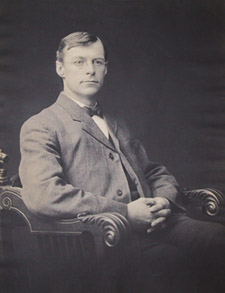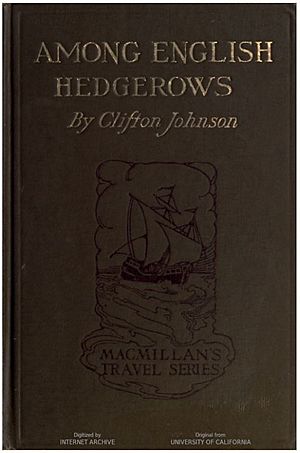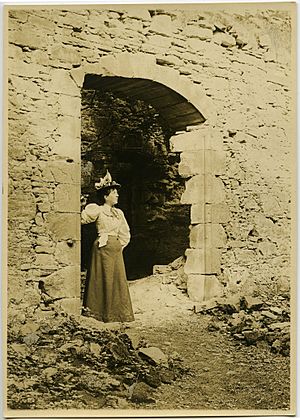Clifton Johnson (author) facts for kids
Quick facts for kids
Clifton Johnson
|
|
|---|---|

Clifton Johnson, circa 1900
|
|
| Born | January 25, 1865 Hockanum, Hadley, Massachusetts |
| Died | January 22, 1940 (aged 74) Brattleboro, Vermont |
| Resting place | Hockanum Cemetery |
| Occupation | author, photographer, folklorist |
| Nationality | American |
| Spouse |
Anna Tweed McQueston
(m. 1896) |
| Children |
Margaret
Arthur S. Roger Oliver Irving Katherine |
| Signature | |
Clifton Johnson (January 25, 1865 – January 22, 1940) was an American author, illustrator, and photographer. He wrote about 125 books, including travel stories, children's tales, and biographies. Many of his books featured his own drawings and photographs.
Contents
Discovering Clifton Johnson: Author and Photographer
Clifton Johnson was a talented American writer, artist, and photographer. He is known for his many books, which often showed the beauty of everyday life. He especially loved to capture scenes from the countryside.
Clifton Johnson's Early Life and Family
Clifton Johnson was born on January 25, 1865. His hometown was a small village called Hockanum in Hadley, Massachusetts. He was the oldest of four children. As a boy, he went to a local one-room schoolhouse. Later, he attended Hopkins Academy in Hadley.
At age 15, Clifton left school. He worked for five years at a bookstore in Northampton. After that, he moved to New York City to study art.
Growing Up by the Connecticut River
Clifton's family farm was right by the Connecticut River. He loved spending time there. He enjoyed boating, fishing, and swimming. In winter, he would go skating on the frozen river. He also had fun helping to free logs that got stuck along the riverbanks.
When he was young, Clifton didn't travel far from Hockanum. He only went as far as Holyoke or Northampton. There, he would sell berries. He once described himself as a "mischievous" boy. He and his friends loved to "borrow" apples and watermelons. In school, he didn't like math or classic subjects. He preferred history and natural science, especially botany. This love for plants allowed him to spend a lot of time outdoors.
Clifton Johnson's Marriage and Children
On May 25, 1896, Clifton married Anna Tweed McQueston. Anna was a local school teacher. For their honeymoon, they traveled to England, Scotland, Ireland, and France. This trip was also a work trip for Clifton.
Clifton and Anna had six children. Their names were Margaret, Arthur, Roger, Oliver, Irving, and Katherine. Sadly, Oliver died when he was a baby. Their son Irving later became a famous sailor. He captained three ships, all named Yankee. He and his wife, Electa, sailed around the world seven times!
Clifton Johnson's Amazing Career
Even though he didn't have much formal schooling, Clifton Johnson became very successful. He was an author, photographer, artist, and editor. He also studied folklore, which is the study of traditional stories and customs.
Carl Withers, an expert on people and cultures, called Johnson a "skillful writer." He also said Johnson was a "pioneer photographer of folk life." This means he was one of the first to take pictures of everyday people and their traditions. Johnson was very good at listening to people's stories. He collected and wrote down many folktales for children. He was interested in American traditions and ways of life.
Early Books and Illustrations
Clifton Johnson's first job as an artist was in 1890. He illustrated a children's book called Wonderful deeds and doings of little giant Boab and his talking raven Tabib. The next year, he illustrated another book by the same author.
Also in 1890, a publisher asked Johnson to take photos for a series called Picturesque Hampshire. He contributed hundreds of photos and drawings to this project. In the 1890s, he also wrote many books about country life in New England. This was a topic he loved. His book New England Country (1892) was very popular. This led to more books like The Farmer's Boy (1894) and The Country School in New England (1895). He also wrote Old-time Schools and School-books (1904). This book looked at how schools used to teach and what old textbooks were like.
Travels and International Books
Because his first books were so successful, publishers sent Johnson on trips. He went to England, Scotland, and Ireland. His job was to take photos for new editions of classic books. In 1896, he also visited France.
He came back with hundreds of photos, drawings, and notes. He also collected many folktales from the people he met. From these trips, he wrote books about each country. These included Among English Hedgerows (1899) and Along French Byways (1900). He also wrote The Isle of the Shamrock (1901) and The Land of Heather (1903). In his books about England, he paid special attention to children. He wrote about their games, festivals, and daily activities.
Clifton Johnson's Writing Style
Clifton Johnson was very interested in the daily lives of people in the countryside. He started writing because of his photography. He said he wrote "to explain the pictures."
He first published articles in local newspapers. His first book, The New England Country, came out in 1892. He wrote travel guides, children's books, and biographies. His travel book series, Highways and Byways of America, explored rustic life in many states.
Johnson preferred to explore "byways" (small, less-traveled roads) rather than "highways" (main roads). He explained that he loved the "humbler features" of places. He wanted to show the "characteristic and picturesque phases of the local farm environment." He aimed to give readers a "clear and truthful impression of the reality" of these places. He often wrote: "My rambling has been in the fields and woodlands, my stopping-places in the little villages and scattered farmhouses, and I write almost wholly of rustic life and nature."
How Johnson Collected Stories
Johnson had a simple way of gathering information for his books. He would talk to people he met. He would get friendly with them until they said something interesting. Then, he would take out his notebook and write it down. If they asked why, he would say it interested him. This method helped him capture real conversations and details.
His travel books were like the notes of an anthropologist. He was very good at capturing how people spoke. He could show different ways of speaking and local accents. He used this same method when writing about famous people like John Burroughs.
Children's Books and Fairy Tales
Clifton Johnson was also good at talking to children. This led him to create books for the growing children's market. He made a series of fairy tale books named after trees. These included The Oak Tree Fairy (1905) and The Birch Tree Fairy Book (1906). He also wrote a fifteen-volume series called Bedtime Wonder Tales.
Johnson's stories often taught good values. He believed in making children's tales more positive. For example, in his version of Little Red Riding Hood, the wolf is killed by the grandmother. Little Red Riding Hood is not harmed. His Mother Goose Tales My Children Love Best (1917) left out harsh parts. Instead, it included rhymes from New England folklore.
Clifton Johnson's Photography
Clifton Johnson was a passionate photographer. He focused on capturing country life and people. His photos of rustic life are very valuable. He bought his first camera in 1888 to help with his drawings. But when a publisher bought his photos, he started focusing more on photography.
He took many pictures in his home state of Hadley and other New England states. He also photographed all across the United States. He took pictures in many cities and villages in France, England, Scotland, and Ireland. He used his photos to illustrate famous books. These included Charles Dickens's Child's History of England (1898) and R. D. Blackmore's Lorna Doone (1900). He also illustrated Henry David Thoreau's Cape Cod (1908) and Walden (1910).
The Art of His Photography
For Johnson, photography was not just about making pretty pictures. He wanted his photos to have meaning. He was deeply interested in New England life and folk traditions. His photos show purpose and beauty. Instead of focusing on unusual things, he chose to photograph the everyday. He turned ordinary scenes into visual poetry.
Johnson thought of photography like painting. He would choose subjects as if he were painting them. He posed people to look "natural." After developing his prints, he would carefully "paint on them." He would add or remove details to make the photo "tell its story more simply and gracefully." He sometimes even painted over almost the entire surface of a print.
Even though old cameras needed people to pose, Johnson's photos look natural. His subjects are in their real environments, doing their usual tasks. His photography showed "life," not just "from life." His models were "not only alive, but living."
Johnson would often retouch his photos. He might add clouds or birds. He would soften bright whites or dark blacks. He even removed objects to make the picture clearer. He used a slight blur to soften details like grass or trees. This made his photos show "not things as they are, but things as they look."
He preferred to work on hazy or misty days. This helped create a soft, blurred effect naturally. Clear, sunny days made pictures too sharp. They would have too many bright spots and shadows. Mist, smoke, or dust softened the strong contrasts.
Johnson also liked to take photos facing the sun. This made subjects look solid and surrounded by air. Subjects lit from the front often looked "shallow and weak."
Clifton Johnson's Travels Across Continents
Clifton Johnson took many long trips across the United States and Europe. He traveled to illustrate and photograph different places for his books. In 1895, a company sent him to England. He was to illustrate a new edition of White's Natural History of Selborne. In 1896, another company sent him to illustrate books by Ian Maclaren and J. M. Barrie. On his third trip to Great Britain in 1897, he took photos for Charles Dickens's Illustrated History of England.
He traveled in many ways: by train, stagecoach, river boat, or even on foot. He liked staying in small towns and villages more than big cities. He preferred sleeping in farmhouses. He felt this gave him a better chance to observe daily life and talk to people. He found large cities too busy and not "authentic." Once, he arrived in London planning to stay for days. But he found it "dingy and commonplace" with too many crowds and noise. So, he quickly took a train north.
Johnson’s Bookstore: A Family Business
In April 1893, Clifton and his younger brother Henry bought a small stationery shop. It was located at 318 Main Street in Springfield, Massachusetts. Clifton helped with the money. The shop was named Henry R. Johnson’s Blank Books. Henry had left school to work at a bookstore to help his family.
Clifton designed the store's logo. It was a shallop, a type of boat used by early settlers on the Connecticut River. This logo stayed with the store as it moved to bigger locations. It was used until the store closed in 1998. When Clifton wasn't traveling, he visited the store every Tuesday and Friday. He was a close advisor and silent partner to Henry. Clifton also helped organize art exhibits at the store. In 1922, Clifton's two sons, Arthur and Roger, bought the store from Henry. The store remained in the family until it closed in 1998.
Community Work and Legacy
Clifton Johnson also gave his time and money to local projects. He served on the school committee. He also wrote a book about his town's history, Historic Hadley: quarter millennial souvenir, 1659–1909 (1909). He made many donations to the local First Congregational Church. He even gave $10,000 for renovations without telling his family.
In 1930, Clifton and Henry worked together to open a farm museum. Henry had collected so many old farm tools that they outgrew his house and Clifton's barn. The brothers wanted to show items important to farm work. A doctor from Boston offered his family's old barn from 1782 as a gift. Instead of taking it apart, the brothers moved the entire building. They moved it whole over the winter and spring! The building was officially opened on May 27, 1930.
Clifton Johnson's Lasting Impact
Clifton Johnson's work continues to inspire people. Three of his photographs from Highways and Byways of the South (1902) inspired poet Natasha Trethewey. She wrote a poem called “Three Photographs.” Each part of the poem was written from a different point of view. Trethewey felt a strong connection to the people in Johnson's photos.
One of Johnson's photos, "Barred Door; Rocky Hill Meeting House," was shown in a special art exhibit. This exhibit, called "American photography, 1890–1965," was at the Museum of Modern Art in New York. It also traveled around Europe.






